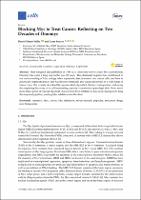Blocking Myc to Treat Cancer: Reflecting on Two Decades of Omomyc
Date
2020-04-04Permanent link
https://hdl.handle.net/11351/6251DOI
10.3390/cells9040883
ISSN
2073-4409
WOS
000535559500094
PMID
32260326
Abstract
First designed and published in 1998 as a laboratory tool to study Myc perturbation, Omomyc has come a long way in the past 22 years. This dominant negative has contributed to our understanding of Myc biology when expressed, first, in normal and cancer cells, and later in genetically-engineered mice, and has shown remarkable anti-cancer properties in a wide range of tumor types. The recently described therapeutic effect of purified Omomyc mini-protein—following the surprising discovery of its cell-penetrating capacity—constitutes a paradigm shift. Now, much more than a proof of concept, the most characterized Myc inhibitor to date is advancing in its drug development pipeline, pushing Myc inhibition into the clinic.
Keywords
Myc inhibition; Cancer; OmomycBibliographic citation
Massó-Vallés D, Soucek L. Blocking Myc to Treat Cancer: Reflecting on Two Decades of Omomyc. Cells. 2020 Apr 4;9(4):883.
Audience
Professionals
This item appears in following collections
- VHIO - Articles científics [1250]
The following license files are associated with this item:

 Private area
Private area Contact Us
Contact Us








